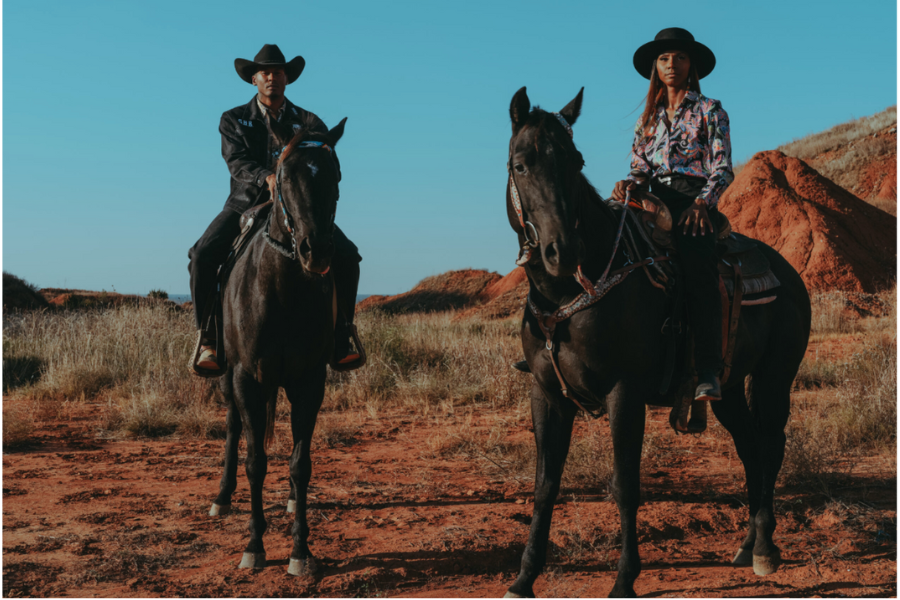How Ivan McClellan’s “Black Rodeo” Is Reclaiming Black Power in America
PHOTOGRAPHY BY IVAN MCCLELLAN
The Photographer Documenting the Unseen Riders of American Resilience
Ivan McClellan has never been one to shy away from the grit of America’s underbelly. A documentarian of raw, unfiltered humanity, McClellan’s latest project, “Black Rodeo,” is more than just an art exhibit—it’s a cultural reckoning. Through the lens of his camera, McClellan flips the script on the often whitewashed imagery of cowboy culture, reclaiming a narrative that has always belonged to Black America.
At its core, “Black Rodeo” isn’t just about rodeos or cowboys. It’s about power, resilience, and an unapologetic reclamation of space in a country that too often erases Black contributions to its identity.
A Forgotten Legacy Saddled in Truth
The mythos of the American cowboy is steeped in folklore. But what Hollywood won’t tell you is that one in four cowboys was Black. These were formerly enslaved men turned cattle herders, who pioneered techniques still used today. Yet, for decades, their stories were trampled under the boot of systemic erasure. McClellan’s work doesn’t just shine a light on this forgotten history—it amplifies it, boldly and beautifully.
The images in “Black Rodeo” hum with electricity. There’s a defiant grace in the way his subjects hold themselves—strong, poised, drenched in sweat and pride. From the bright threads of intricately embroidered shirts to the palpable grit of the arena dirt, McClellan captures every ounce of spirit that makes these cowboys and cowgirls icons of a cultural renaissance.
Riding for Black Power
McClellan’s lens is sharper than a bull rider’s spurs, framing his subjects as modern-day warriors reclaiming their rightful place in the American imagination. But his work isn’t just about aesthetics; it’s a political statement. In a country still grappling with racial inequities, the Black rodeo circuit becomes a symbol of rebellion, resilience, and self-determination.
“I want these photos to remind Black folks that we’ve always been here,” McClellan said at the exhibit’s opening. “We’ve always been a part of this story.”
The exhibit’s crown jewel, a striking black-and-white portrait of a young Black girl in a cowboy hat, feels like an anthem. Her eyes burn with determination as if daring the viewer to rewrite her story. This is McClellan’s genius: he doesn’t just document; he ignites.
And if you’re intrigued by his photography, don’t miss his short film, 8 Seconds—a cinematic dive into the grit, glory, and unrelenting heart of the Black rodeo circuit. The film perfectly complements the exhibit, capturing the pulse of a subculture riding tall in a world that tried to forget them.
Art as a Weapon of Reclamation
McClellan’s art is as much about visibility as it is about power. In an age where Black Lives Matter has redefined activism, “Black Rodeo” rides shotgun, reminding us that Black identity is multifaceted. It's not just resistance marches or protest signs—it’s joy, tradition, and culture thriving against all odds.
“I’m reclaiming this space because it was never truly lost,” McClellan says. “It was stolen. And now, we’re taking it back.”
The rodeo becomes a stage for liberation, where the stereotype of the lone white cowboy crumbles under the weight of truth. The riders in McClellan’s photos exude an effortless cool, their confidence radiating like the sun over an open plain. And in every frame, there’s a story waiting to be told—a love letter to a legacy that refuses to be buried.
Bringing the Rodeo East
As McClellan’s work gains traction, he’s set his sights on breaking more barriers. The Black Rodeo is gearing up to come to the East Coast, a region that knows less about diamond-studded boots and belts and more about facial piercings. It’s a bold move that underscores McClellan’s mission to bridge cultural gaps, not just racially but geographically.
His work breaks boundaries that go beyond race, diving into the heart of what it means to be American—balancing pride in one’s roots with a shared cultural identity that binds us all. The East Coast may be a long way from the open plains of Oklahoma, but McClellan is ready to prove that the cowboy spirit is universal.
A Movement in Motion
The response to “Black Rodeo” has been seismic. Social media is ablaze with posts from fans calling McClellan a “visual griot” and “a cultural architect.” Influencers, activists, and artists alike have flocked to the exhibit, eager to experience its visceral power. In the middle of it all, McClellan remains humble, yet resolute.
“This isn’t just an exhibit,” he says. “It’s a movement.”
That movement extends far beyond gallery walls. “Black Rodeo” has sparked conversations about representation, land ownership, and generational wealth in Black communities. The exhibit reminds us that reclaiming power isn’t just about history—it’s about shaping the future.
Saddle Up for Change
Ivan McClellan’s “Black Rodeo” isn’t just a snapshot of Black excellence—it’s a battle cry. It dares us to confront the sanitized narratives we’ve been fed and asks: What happens when we stop letting others tell our stories?
In the end, “Black Rodeo” is more than a gallery of images. It’s a reminder of the unyielding spirit of Black America, a testament to the riders who refuse to be bucked off the horse of history. McClellan has given us not just a body of work, but a living, breathing celebration of Black power.
So saddle up. The ride’s just getting started.
#SOAPBOX #BLACKRODEO
IVAN B. MCCLELLAN
Ivan McClellan (b. 1982, Kansas City, KS) is a photojournalist and designer based in Portland, Oregon. His work reveals marginalized aspects of black culture and challenges broad assumptions and myths about racial identity in America.
Instagram: @eightsecs
Website: www.eightsecs.com
See a typo or inaccuracy? Please contact so it can get fixed!








Reconnect with your inner child and rediscover your authentic self by unlearning the noise of conditioning. A soulful guide to self-awareness and healing.